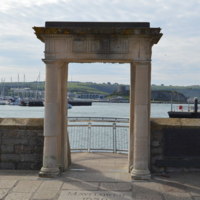Description
In 1889, a huge Monument to the Forefathers was erected in Plymouth, Massachusetts, and interest in the Mayflower was hotting up on both sides of the Atlantic. Two years later in 1891 a delegation of American descendants and representatives made their way to the International Congregational Council in London – and also toured the Pilgrim hotspots of England. The first Mayflower memorial in Plymouth was unveiled in that year: a simple stone, engraved ‘Mayflower 1620’, set into the pavement in the harbour.
By the 1930s, after apparently being a subject that was considered for around 30 years, the topic of building a new memorial burst into life. Leading the charge was the Old Plymouth Society, a civic body made up of the great and the good – from Sir Philip Pilditch to Stanley Leatherby (the current Mayor). They were concerned that the existing memorial was a ‘mean and unworthy effort’, ‘inadequate… for so important an international event as the branching off and birth of a new nation’. Compounding the problem was the fact that the old memorial was getting covered in oil from the buses – no way to encourage (rich) visitors from that nation that their history was treated with the right amount of respect in the Old World. In general, the Old Plymouth Society was concerned that the historic beauty of their town was being despoiled by an unsympathetic and too commercially minded municipal government. Looking to the pretty towns of France, Belgium and Holland, Lieutenant Colonel W.P. Drury, another member of the Society, complained that ‘The ashes of Vesuvius did scarcely more irreparable damage to Pompeii… than an unintelligent vandalism has wrought during the past five decades in Elizabethan Plymouth.’
In the early 1930s, the eighteenth-century Old Customs Watch House on the Barbican’s West Pier – one such piece of historic Plymouth - had been pulled down. Left over were four granite columns; the least the Council could do, the Society argued, would be to repurpose them in a new and grander memorial for the Mayflower. They sent designs into the City Council early in 1934 to this effect, but the Works Committee rejected them – favouring instead the use of Portland stone in a Doric temple style. Over the next few months, debate raged in the local press, led by editorials in the Western Evening News - who were firmly on the side of a bigger and more impressive memorial.
Many arguments were made for a memorial different to the modest one suggested by the Council: Portland stone was ‘foreign’ in comparison to granite; the memorial was not big enough to operate as a shelter for local fisherman (like the Watch House had); or, quite simply, whether the memorial was ‘imposing’ enough. Another argument revolved around whether a campaign should be inaugurated to raise money from both sides of the Atlantic, thus becoming a properly ‘international’ monument to the Pilgrims (favoured by Lord and Lady Astor) or whether this would be seen as begging that made the city appear ‘small in the eyes of the nations of the world’ (insisted by Pilditch). Not everyone was obsessed with how impressive or transnational the memorial could (or should) be, however; some, like the Bishop of Plymouth, thought that a simple and dignified memorial would be more in line with the sober ideals of the Pilgrims than ‘anything on a grandiloquent scale’.
In the end, the City Council won out; the new memorial was understated, and costed a modest £235. The original 1891 memorial was incorporated into the design by being moved in front of the small Grecian arch, and another tablet in the side of the monument announces that it was unveiled by the Mayor and was paid for by the local civic figure Sir Frederick Winnicott. It was, as the Western Morning News now reported, ‘symbolic of the spirit that moved the Puritans in its sturdiness and lack of adornment… a white gateway to the ocean.’
In the summer of 1934, after members of the city council and civic elite had ceremonially paraded to the monument a ‘large and distinguished gathering’ – including American representatives – saw the Mayor pull off the Union Jack and Stars and Stripes to reveal the monument. Speeches lauded the piety of the Pilgrims and their ‘eternal struggle for liberty and freedom’. Sir Pilditch, and perhaps other members of the Old Plymouth Society, did not attend. In their annual report, they rather sniffily said that ‘It was a matter of deep regret… that sufficient time was not allowed to mature a considered scheme for the production of a Mayflower memorial commensurate with its object – the commemoration of an event of international importance.’ Nonetheless, they were happy to claim the ‘initiative’ for having a new memorial erected at all.
In following decades the memorial was the site of ceremonies around moments of Mayflower interest, and is still a popular visiting site for Americans today. Other plaques have also been added to the surrounding area. In 1955, for example, a special return pilgrimage of 104 American Pilgrim descendants (plus 48 guests) toured Holland and England to visit the birthplaces, churches and departure points of their ancestors. Led by the Governor-General of the General Society of Mayflower Descendants, Society, Lieutenant-Colonel Waldo Morgan Allen, they came ‘in the name of Anglo-American friendship’ and to perpetuate the memory of the Pilgrim Fathers. On the Barbican, as part of this trip, they gifted and unveiled a bronze plaque – embossed with the Mayflower – to mark the occasion.
Source
‘Mayflower Stone “A disgrace”’, The Western Morning News (20 January 1934), 5.
‘Memorial to Pilgrim Fathers’, Western Morning News (30 April 1934), 5.
‘Mayflower Memorial’, Western Morning News (1 May 1934), 5.
‘More imposing mayflower memorial’, Western Morning News (22 May 1934), 5.
‘Mayflower Memorial’, Western Morning News (24 May 1934), 5.
‘Memorial after 314 years’, The Western Morning News (6 September 1934), 5.

